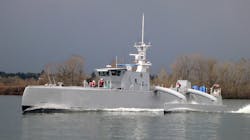DARPA asks for unmanned surface warships, rugged electronics, with no accommodation for human presence
ARLINGTON, Va. – U.S. military researchers are asking industry to design and test a 100-ton unmanned surface vessel (USV) of about 65 feet in length with no accommodations for human presence, access, operation, or habitation.
Officials of the U.S. Defense Advanced Research Projects Agency (DARPA) in Arlington, Va., issued a broad agency announcement on Monday (HR0011120S0017) for the No Manning Required Ship (NOMARS) program.
This project seeks a demonstrate vessel and maintenance and logistic plan for a 100-ton class unmanned vessel with no provision or allowance for humans on or inside the ship to demonstrate capabilities unconstrained by a human presence.
This project is to help the U.S. Navy develop a fleet of many relatively small surface warships to replace or augment the capability of a few high-value ships, DARPA officials explain.
Related: Navy pushes shipboard unmanned systems, lethality upgrades
Many of today's USVs are limited because of the frequency of maintenance that requires human intervention either at-sea or in port. Researchers point out that a human presence comes with a cost.
Current and planned unmanned vessels typically must include physical access to subsystems, ad-hoc maintenance crew quarters, environmental controls, lighting, displays, and safety equipment. This can prevent design exploration into new technologies and new approaches to ship architectures to optimize for survivability and performance.
Instead, NOMARS seeks to enable the unmanned vessel to demonstrate significant performance improvements and enhanced capabilities without the constraints imposed by a human presence.
NOMARS has two parallel thrusts: make the most of seaframe performance when human constraints are removed; and achieving sufficient vessel maintenance and logistics for long-endurance unmanned operations.
Related: Ocean mines have nowhere to hide
The first objective will focus on unusual hull forms, low freeboard, minimizing air-filled volumes, innovative materials, and repurposing or eliminating space for humans.
The second objective focuses on isolating delicate equipment from seawater, ruggedizing hardware, exploring distributed system designs, and developing architectures optimized for depot-maintenance.
The idea is to design more capable and affordable small warships that can be procured and maintained in large numbers. The typical NOMARS unmanned vessel must be able operate over entire battle theaters in one-year deployments.
These vessels must be able to transit at cruise speed for at least 2,000 nautical miles to a deployment station, where they would maintain position for days and weeks at a time, with occasional repositioning at cruise speeds.
Related: Coast Guard looks for unmanned ocean vehicles to hunt smugglers, poachers, and icebergs
This vessel should be able to sprint to reposition or evade the enemy. When finished, NOMARS vessels would conduct a return trip of more than 2,000 nautical miles back to their home ports.
This solicitation concerns only the NOMARS program's first two-track first phase, and will spend about $31 million. Several contracts are anticipated. The program's first phase concerns seaframe design and integration, conceptual design, preliminary design, and risk reduction. The eventual second phase will involve detailed design, fabrication, assembly, and demonstration.
Companies interested should submit proposals no later than 2 April 2020 to the DARPA BAA Website at https://baa.darpa.mil. Email questions or concerns to DARPA at [email protected].
More information is online at https://beta.sam.gov/opp/dc4233cf116e4852ba4c7b436db95ae2/view.
About the Author
John Keller
Editor-in-Chief
John Keller is the Editor-in-Chief, Military & Aerospace Electronics Magazine--provides extensive coverage and analysis of enabling electronics and optoelectronic technologies in military, space and commercial aviation applications. John has been a member of the Military & Aerospace Electronics staff since 1989 and chief editor since 1995.

